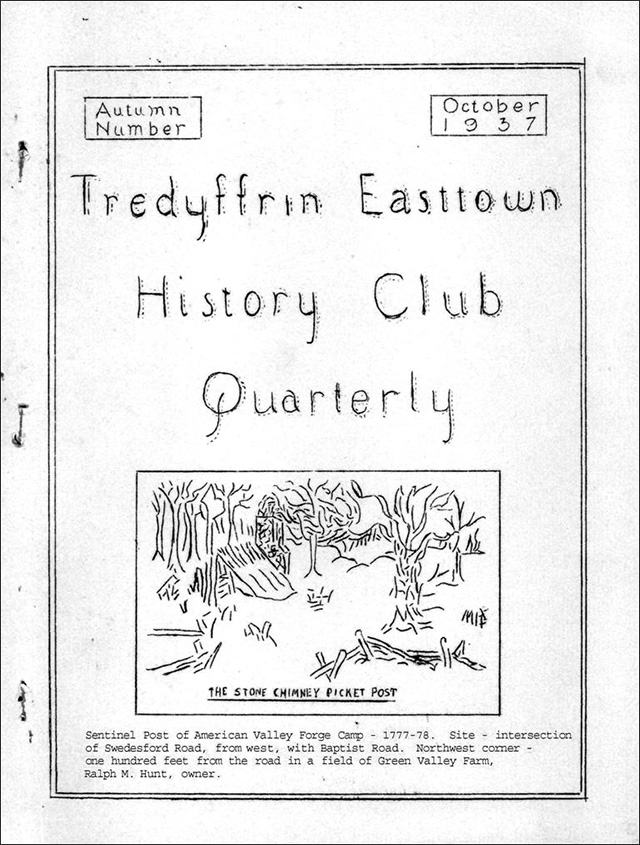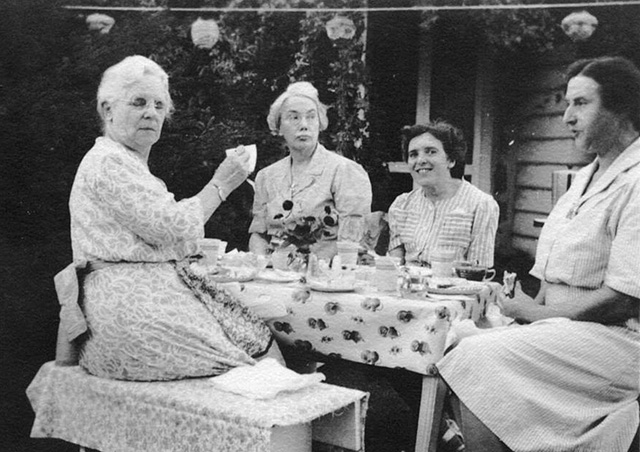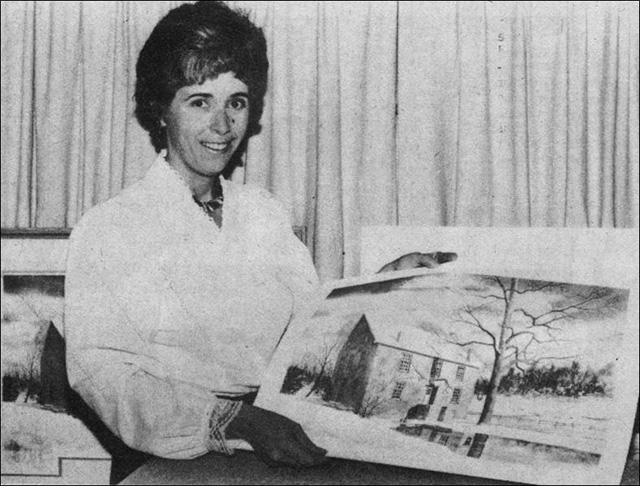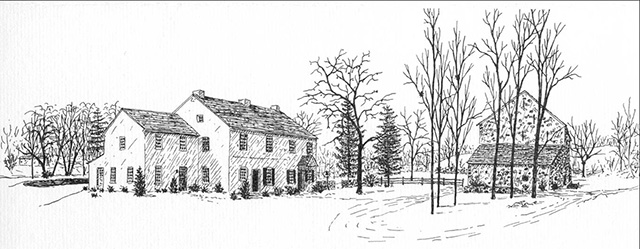|
Home : Quarterly Archives : Volume 44 |
Tredyffrin Easttown Historical Society |
|
Source: Fall 2007 Volume 44 Number 4, Pages 148–179 70 YEARS OF PUBLISHING THE QUARTERLY – continued HOW AND WHY THE QUARTERLY CAME TO BE Three things led to the idea of the Tredyffrin Easttown History Club Quarterly. First, the Constitution of the Tredyffrin-Easttown History Club lists 7 Objectives, the first of which is “Research in the history of Tredyffrin and Easttown Townships and relative adjoining areas.” Second, the original By-Laws, Article I, lists 4 categories of membership: Active, Associate, Honorary, and Contributing. An Active member is “one who is willing to take on a project and piece of ‘Historical Research Work,’ with the view of making a contribution to the Club Records ...” Third, S. Paul Teamer, a history teacher at the Tredyffrin-Easttown High School, had an unusual method of teaching history. Recognizing the possibilities of a section so rich in historical lore, he conducted his classes on field tours, making such names as Valley Forge, Paoli, Brandywine and Gettysburg more than mere works on a printed page. . . . His talks were usually illustrated with maps of his own making Quarterly, vol. 3, no. 3 (July 1940), p. 51]. He continued these methods when he co-founded the History Club and field trips were the most prominent activity during the first few years of the Club. With member Franklin L. Burns' detailed reports of each trip and his and Mr. Teamer's itinerary maps of many of the trips, the Club was quickly amassing a body of valuable material. At the regular Club meeting on August 9, 1937 the club decided to have a “quarterly magazine starting with the fall issue” and appointed the first Quarterly Committee of Dr. A. W. Baugh, Dr. J. Alden Mason, Mrs. John Croasdale (Mary), and Mrs. Charles F. Bradley (Mildred) [M8/9/37]. At the next meeting the membership “decided to call our Quarterly the Tredyffrin Easttown History Club Quarterly” [M9/13/37]. The Publication Committee, as it was later called, is always a major TEHC committee in the early years and it gradually evolved to take on the editorial work that had been done earlier by all members during regular meetings of the Club. The chair of the committee is the editor of the Quarterly. Editors The Tredyffrin Easttown History Club Quarterly/Tredyffrin Easttown History Quarterly has had just 9 editors during its 70 years of publication. They are quite a distinguished group. There have been ups and downs in getting issues out during these years and some long gaps when there was no leadership to keep production schedules running smoothly and regularly, if at all. Then new leaders emerged from unexpected sources to infuse new energies and outlooks to the Quarterly and revive it with renewed vigor. Those with editorial talents often started out as assistants, then sometimes moved up to the position of editor, then sometimes moved on to become president of the organization—or became president first and editor after that. Often editors did their own research and writing at the same time they were putting out the Quarterly—or running TEHC. In times when there was more work than there were people to do it, positions seem to have been routinely exchanged and traded among those passionate about local history who were willing to expend their volunteer efforts to get the many stories of this area published. Families In almost all instances, family members of the editors were quickly drawn into the process of publishing the Quarterly. In the more recent years, as the job of editing and producing the Quarterly became increasingly more complex, it became more than one person and a staff could handle. Family members stepped in to do many of the small tasks, such as keeping the business records, transcribing tapes, proofreading articles, stapling issues, checking facts, obtaining copies of digital images, verifying necessary permissions and credits, delivering copies, etc., etc. In the cases of editors Howard S. Okie and Herb Fry, deaths in their family contributed to brief interruptions in the publication of the Quarterly. The devotion of the Wandless family, Franklin, Fanny, and Myrtle, who almost single-handedly kept the Quarterly—as well as TEHC—going in the 17 years between 1950 and 1967, still elicits our extreme thanks 50 years later.
THE FIRST ISSUE 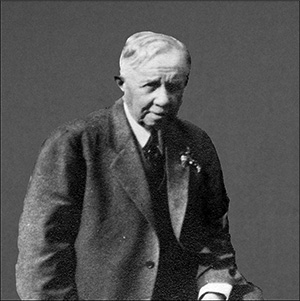
A. W. Baugh. Photographer and date unknown. Courtesy Herb Fry. A[nthony] W[ayne] Baugh, M. D., Editor 1937 (Volume 1, nos. 1-2) Dr. Baugh was born May 6, 1867 and grew up in the Great Valley. He was a graduate of the University of Pennsylvania Medical College in 1892 and married Mary Elizabeth Williams of Berwyn, on June 28, 1899. He was school director and secretary for 2 terms and school physician in Tredyffrin. He lived in Paoli on the southeast corner of Lancaster Pike and Darby Road. He was “most happiest seated in the automobile beside the late Professor Teamer, road-map in hand” [From his obituary, Quarterly, vol. 6, no.2 (1945), p. 36]. He died on November 8, 1938. He lived only long enough to be the editor of the first two issues of the first volume. Dr. Baugh wrote 1 article and 2 editorials for the Quarterly. The first Quarterly editor, A. W. Baugh, stated the reason for producing the Quarterly in an editorial on the first page of the first issue: A number of papers have been read at our meetings which are of a high order and should be preserved, their thought led to the idea of a publication to be called the T-E Historical Quarterly and we hope this our first issue will prove to be of interest to everyone [Quarterly, vol. 1, no. 1 (Autumn Number – October 1937), p. 1]. The first issue has the date of Autumn Number – October 1937. According to the Club Minutes the specific date of publication was September 26, 1937 [M10/11/37]. The cover has a title drawn in freehand and a drawing [artist not given] of the Stone Chimney Picket Post used during the Valley Forge encampment. A major early effort of the Club was to research the site of this sentinel picket post and place a historical marker there on August 1, 1939.
Since the Club's colors were green and white - the colors of the Welsh flag - a green cover was adopted for the first Quarterly, a practice that continued for the next 159 issues - up through the April 2003 issue. During these 66 years the shade of the green covers varied greatly, apparently depending on the stock of green paper available at the time; these could be said to range between a dismal swamp green and a bright lime green. The quality of the green paper varies widely and some of the covers are very deteriorated and have become very brittle over time. 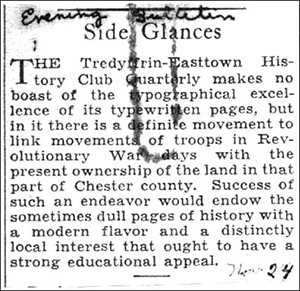
Philadelphia Bulletin, November 24, 1937. The issue has 15 pages and in addition to Dr. A. W. Baugh as the editor it lists a staff of 4: Dr. J. Alden Mason, Mrs. John P. Croasdale (Mary) who lived in the second Blue Ball Tavern, Mrs. Charles J. Bradley (Mildred), and S. Paul Teamer. In addition to Dr. Baugh's editorial there are 3 articles:
The editorial team originally produced 50 copies of this first issue which sold out quickly. They ran off another 50 or 100 copies - the number varies - which also sold out. Accolades poured in.
THE NEXT 12 ISSUES It wasn't until 6 issues after the first editor, Dr. Baugh, died that S. Paul Teamer came forth as the second editor of the Quarterly. Numbers 3–5 of volume 1 and numbers 1–3 of volume 2 had no editor. The issue after Mr. Teamer died—volume 3, no. 3 (July 1940)—is a memorial issue to him. The final issue of volume 3 has no editor. S[amuel] Paul Teamer, Editor 1939 – 1940 (Volume 2, no. 4 – Volume 3, no. 2) 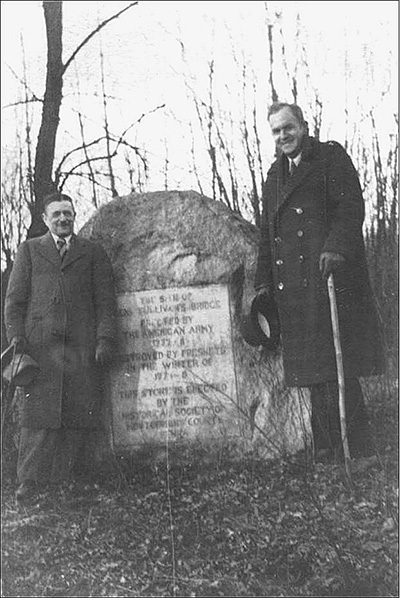
Frank Burns, left, and S. Paul Teamer, right, at Sullivan's Bridge on a January 9, 1938 TEHC trip. Photographer unknown. Tredyffrin Easttown Historical Society collections. Professor Teamer had endeared himself to our members as a leader, constructive critic, and friend. His devotion to the study of history had gained him state-wide recognition as an authority on the military campaigns of our countrymen. As a teacher of history he led our members over battlefields and encampments, imparting to us practical knowledge not gained from books. As a cartographer and lecturer he was accurate and inspiring [Sources: (1) From a resolution dated July 2, 1940 passed at the time of his death by TEHC, Quarterly, vol. 3, no. 3 (July 1940), p. 49; (2) “In Memoriam – Samuel Paul Teamer,” Quarterly, vol. 3, no. 3 (July 1940), pp. 50-51]. Professor Teamer was born in Malvern on August 23, 1890. He graduated in the first class from the new Tredyffrin-Easttown High School (T-EHS) in 1908 and from Bucknell University in 1913. After that he returned to T-EHS as a teacher and coach of the football team and became principal in 1915, a position he held for 25 years. He obtained a Master's degree from the University of Pennsylvania in 1925. During World War I he served overseas from 1917 to 1919 as First Lieutenant in the 311th Field Artillery, 79th Division. He returned to T-EHS in 1919. During his military service he contracted a leg infection that resulted in a hardly noticeable limp, but eventually led to his death. He married Mildred Brown of Green Tree in 1930. They leased the house of the late Professor MacNamee on Conestoga Road across from T-EHS where he was still living at the time of his death. He was a member of Post No. 646 of the American Legion, the Paoli-Malvern-Berwyn Rotary Club, the Tredyffrin Country Club, and the Chester County Historical Society. He was a Trustee of the Paoli Monument Association. He was a co-founder of TEHC on August 4, 1936 and president from its beginning until his death on June 24, 1940 as he approached the age of 50. All monthly meetings were held in his home as were the organization's archives. Mr. Teamer wrote 9 articles, 2 editorials, and 1 poem for the Quarterly. Unfortunately, Mr. Teamer edited only 3 issues of the Quarterly before he died on June 24, 1940. Active Club members had taken on their own research projects and were beginning to produce reports which, in almost all instances, were reproduced in the Quarterly. By the 3rd meeting of the Club the Minutes lists 7 members and their research topics: Cockletown, titles and deeds in the vicinity of the Tredyffrin-Easttown High School, Valley Forge, churches, roads, valley farms, and schools [M11/3/1936]. Club members were first required to read their reports at a regular Club meeting. After that, their reports were openly discussed and revised at monthly meetings before they were considered accurate and acceptable for publication. This practice of publishing most of the presentations given at the Society's monthly meetings in the Quarterly continues to this day, but now with an editorial staff doing all the pre-publication work. By volume 1, number 2 (January 1938) the Quarterly began to take on the look of a regularly published magazine - this is what the early editorial staff called it. These features included:
Inside front and back covers were occasionally used as pages. When poetry—and there was quite a lot of it—was published in these early issues, it often appears on either inside cover. Such practices as these ceased later when more experienced editors modified the look of the Quarterly so it conformed to more standardized publishing formats. Artists and Cartographers It isn't until the last issue of volume 1 (Fall Number October 1938) that there is any recognition of the work of the artists and cartographers which by now was appearing regularly in the pages of the Quarterly. An anonymous editorial in this issue explains: “Many of our sketches have been made from treasured old photographs, and others from rare engravings, some from crude drawings, while some of the best have been sketched directly from the originals” [Quarterly, vol. 1, no. 5 (Fall Number, October 1938), p. 1]. As production methods improved over time, illustrative matter in the Quarterly evolved from drawn images to copies of original material to digital reproductions. The first drawing—Valley Forge Memorial Arch—was in the second issue and was by Caroline Logan of Strafford who produced many drawings for the Quarterly. Another early artist was Avery Okie. The first maps that were not itineraries of Club trips also appeared in the second issue. These are a series of local tract maps showing property ownership in Tredyffrin and Easttown Townships and are drawn by Club member Howard S. Okie, Esq. Copyright Statements Copyright is a complex issue and it takes a trained and analytical mind to know when to use it. A single separate copyright statement was used in 2 early issues.
A regular copyright statement was placed in each issue when Joyce A. Post became the editor in 2004. Copyright law had changed by this time to give authors ownership of their individual works and to retain control over future publication of them. Joyce Post just happens to be a librarian. 1941 – 1978 (volumes 4 – 16) The 13 years between 1941 and 1953 and the 6 years between 1968 and 1973 were rocky times to be at the helm of the Quarterly. The issues published in 1941, 1942, 1943, 1953, and between 1968 and 1973 had no editor. No issues were published in 1946 or 1950 or 1951 or in the 5 years between 1974 and 1978. In the 12 years between 1944 and 1955—volumes 6, 7, and 8—publication was irregular with 12 issues published. The 6 years between 1968 and 1973—volumes 15 and 16—are also irregular with 6 issues published. World War II World War II had a lot to do with the irregularity of volume 5 published in 1942 and 1943. Beginning with this volume the Quarterly went to a publication schedule of 2 issues a year which continued, with occasional large irregularities, through volume 16, no. 2 in 1973. The volume and issue numbering sequence of 4 issues per volume adopted with volume 1 is retained. Every volume has 4 numbers regardless of the date of an issue in that volume - a policy that continues to this day. The 4 issues of volume 5 had no editors. But a staff of 8 - Franklin L. Burns, Mr. and Mrs. William T. Mansley, Hilda E. Heagy, J. Alden Mason, Phoebe P. Prime, Ruth J. Moore, and Mildred F. Bradley—kept it going through 1942 and 1943. The first number in 1942 can be thought of as the “war issue” of the Quarterly. There are articles about the Berwyn lookout post, the local air raid defense wardens, the local war gardens, the Paoli branch of the American Red Cross, and the Berwyn knitting class. The USO emblem is the cover illustration. It isn't until the 3rd number of volume 5, published in 1943, that there is any mention of the Club's concerns about whether to publish the Quarterly at all during this time. The Quarterly has very few other articles written during the war about its local effects, although there were occasional additional articles about local Red Cross activities. There is much more interest about WWII after the fact and at least 10 more articles have been written since then. The most recent one is a photograph-based article about “The Pennsylvania Railroad During World War II” in the Spring 2005 issue. Howard S[pencer] Okie, Esq., Editor 1944 – 1945 and 1952 – 1953 (Volume 6, nos. 1 and 2 and Volume 7, nos. 3 and 4) 
Howard S. Okie. From a larger photograph taken at TEHC's first picnic on August 4, 1942. Photographer unknown. Tredyffrin Easttown Historical Society collections. Howard S. Okie was born in 1882 in Berwyn and was a graduate of the University of Pennsylvania Law School. He was a brother of Mary Gurney Okie, who married John Croasdale; she was one of the founding members of TEHC. He married Alice L. Thomas of Devon in 1910 and Lucy Duhring in 1946. He was a resident of Easttown, a member of the Philadelphia Bar and was admitted to practice before the Supreme Court. He was admitted to the Chester County Bar on June 26, 1915. He died on December, 29, 1973 [Sources: (1) “Desires to Enter the Bar,” Daily Local News, January 30, 1908; (2) “Admitted to the Bar,” Daily Local News, June 6, 1915]. Mr. Okie experienced several family events which would seem to account for some of the irregularities in his term as editor. His half-brother, Richardson Brognard Okie, died in December 1945, he remarried late in 1946, and his wife died 7 years later in September 1953 [Sources: (1) M12/9/46; (2) TEHC Resolution on the death of Mrs. Howard S. Okie, September 24, 1953; (3) Quarterly, vol. 13, no. 2 (October 1964), p. 35]. No issues were published in 1946, 1950, or 1951. Myrtle Wandless and Mildred F. Bradley filled in for him and edited the 4 issues published between 1947 and 1949. There was a 2½-year publishing gap between the end of 1949 and July 1952, when Mr. Okie returned as the editor. He no longer appears on the editorial staff of the Quarterly after 1953 although he did continue to write for it. With World War II, people became more aware of the importance of medicine. Berwyn was served by a large number of physicians and the Quarterly began a series of biographies of 5 of them during Mr. Okie's editorship. The first two - Dr. James Rickabaugh in volume 6, no. 1 (1944) and A. W. Baugh, M.D. in volume 6, no. 2 (1945) - were published at this time. When Mr. Okie returned as editor in 1952 with volume 7, no.3 it was with a major special issue devoted to the history of Berwyn on the celebration of its 75th anniversary. Two articles—one by Mr. Okie and an earlier one by Mr. Burns—are complete with many drawings of early buildings and a keyed map of 34 locations in the Berwyn area. Mr. Burns' article includes a list of 17 “Historic Sites within a few miles of Berwyn.” There is also an extensive list of 22 earlier articles in the Quarterly about the area. Mr. Okie wrote 19 articles for the Quarterly. Eight were articles on “Local Titles in Easttown and Tredyffrin” and 4 were articles on “Old Lancaster or Conestoga Road,” written before he became editor. Seven were general articles. He also wrote 1 editorial.
Myrtle Wandless, third from the left, at the August 4, 1942 TEHC picnic at the home of Mrs. Hilda Heagy. Left to right: Ruth R. Mansley, Katharine M. Stroh, Myrtle, Mrs. Hilda Heagy. Pgotographer unknown. Tredyffrin Easttown Historical Society collections. Myrtle Wandless, Editor 1947 (Volume 6, nos. 3 and 4) Myrtle was the daughter of Franklin W. and Fannie R. Wandless who lived at 218 Warren Avenue, Berwyn. She was a graduate of the Tredyffrin-Easttown High School and received her B.A. from Temple University and her M.A. from Columbia University. She was the head of the home economics department of Nether-Providence High School for 35 years before retiring. She died on January 1, 1968 after a short illnesss. At the time of her death she was the president of TEHC. [Daily Local News, January 3, 1968]. She had been TEHC secretary in 1947, 1950-51 and 1962-63; vice-president in 1964-1965; and president in 1966-67. Myrtle wrote 6 articles for the Quarterly and contributed to the first cumulated index to the Quarterly published in 1965. Myrtle stepped in, in still another capacity, as she always did for TEHC and edited these 2 issues of the Quarterly in 1947. The deaths of loyal supporter, Richardson Brognard Okie, on December 27, 1945 and Franklin L. Burns, ornithologist and prolific local writer, on February 7, 1946 no doubt contributed to some of the reasons why no quarterlies were published in 1946. Myrtle published tributes to R. B. Okie on pages 52-53 and to Franklin Burns on pages 46-51 of volume 6, no. 3. The 3rd biography in the ongoing series about physicians in Berwyn -Dr. James Aiken -appeared under Ms. Wandless' editorship in volume 6, no. 4, although this issue has a guest editor, George P. Orr. Mildred F. Bradley, Editor 1948 – 1949 (volume 7, nos. 1 and 2) 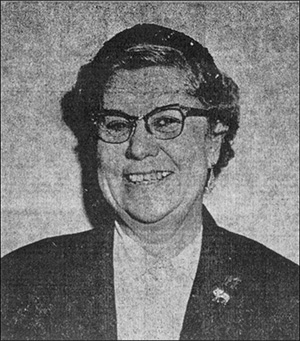
Mrs. Mildred F. Bradley, later Mrs. Mildred F. Fisher. Upper Main Line News, April 6, 1956. Mrs. Bradley was born at Rose Tree, Delaware on November 20, 1892. She was a State Revenue Agent—and the only woman agent—for 11½ years in the Pennsylvania Bureau of Institutional Collections and had offices at the Pennhurst State School. She was very interested in civic activities and was an officer of several prominent state and local womens', business, and political organizations. She was a member of the Valley Forge Historical Society and the King of Prussia History Club. She died unexpectedly at home, on April 6, 1966, at the age of 73. At the time of her death her address was 828 Old Lancaster Road, Berwyn, on the northwest corner of the intersection with Howellville Road, where she had lived for 44 years. [Sources: (1) Quarterly, vol. 8, no. 4 (October 1955), p. 79; (2) Upper Main Line News, April 6, 1956; (3) Quarterly, vol. 13, no. 4 (October 1965), pp. 74-75; (4) Daily Local News, April 7, 1966]. Mrs. Bradley was the first secretary of TEHC - the first Minutes are signed by her. She was TEHC Business Manager of the Quarterly in 1940-42, the first vice-president of TEHC in 1944-45, and president in 1946-47. She married LeRoy Fisher sometime, it is thought, between December 1948 and December 1949. As Mrs. Mildred F. Bradley she wrote 8 articles for the Quarterly, 6 of which were about local schools, 2 were editorials, 2 were reports from the TEHC secretary, and 2 were poems. As Mrs. Mildred F. Fisher she wrote 15 more articles for the Quarterly. The 4th and final articles in the ongoing series about physicians in Berwyn - Charles Joseph Roberts, M. D. and Dr. Walter Burrell Farley - were published under Mrs. Bradley's/Fisher's editorship in volume 7, nos. 1 and 2. Two more installments in the ongoing series chronicling interments in local church cemeteries also appeared in her 2 issues. These covered Old Salem Church. J[ohn] Alden Mason, Editor 1954 – 1967 (Volume 8, no. 2 to Volume 14) 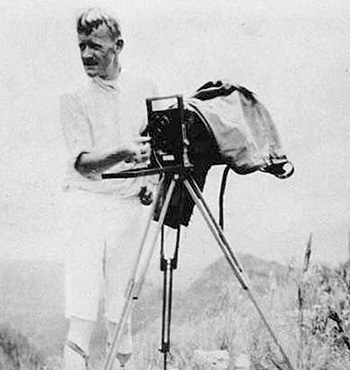
Dr. J. Alden Mason with camera, Puerto Rico, 1911. Courtesy University of Pennsylvania Museum of Archaeology and Anthropology. Dr. Mason was born on January 14, 1885 in Germantown and graduated from Central High School, Philadelphia, in 1903. He attended the University of Pennsylvania, receiving an anthropology degree in 1907 and did graduate work at the University of California at Berkeley, receiving a Ph.D. in anthropology in 1911. He participated in 24 field expeditions between 1910 and 1955 in the United States and Central America. He was a curator of archaeology at the Field Museum in Chicago and the American Museum of Natural History in New York City before coming to the University of Pennsylvania Museum of Archaeology and Anthropology in 1926 as curator of the American Section from which he retired in 1955. Along the way, in 1940, he became the editor of American Anthropologist. In 1940 he led an expedition to Panama and excavated a site yielding many fantastical ceramic and gold ornaments that now adorned the skeletons of the local chiefs. The find was so extraordinary that the University Museum prepared an exhibit, “River of Gold: Precolumbian Treasures from Sitio Conte,” that has been displayed there 3 times: in 1988, 1992, and 2007. Dr. Mason lived at 725 Conestoga Road, Berwyn. He was an early member of TEHC and its president in 1944. He was an editor of the Quarterly for 14 years and brought much needed stability to the publication schedule after it had been irregularly published during the previous 13 years. Dr. Mason died on November 7, 1967 at the age of 82, just one month after he edited his last Quarterly in October 1987 [Sources: (1) J. Alden Mason. “The Archaeological Expedition of the University Museum to Panama (1940),” Quarterly, vol. 3, no 3 (July 1940), pp. 53-57 and vol. 3, no. 4 (October 1940), pp. 87-92; (2) Elizabeth Goshorn. “A Legacy of John Alden Mason,” Quarterly, vol. 26, no. 3 (July 1988), pp. 105-116; (3) http://www.museum.upenn.edu/SitioConte/related/reference/biography/mason/ad1998-583.1.htm (4) Tom Avril. “Glittering Discovery,” The Philadelphia Inquirer, September 10, 2007, pp. D1-D2] Dr. Mason wrote 14 articles for the Quarterly, 3 editorials, and 1 poem. Dr. Mason saw a direct relationship between his experiences in the field and the mission of local history groups. He published two editorials in the Quarterly describing this. Every amateur archaeologist is continually being told by the professionals that he can become the authority on the archaeology of his township or county, and that this should be rather than the accumulation of a collection of interesting specimens from all over the world. This advice applies equally well to the amateur historian.. . . . What would we not give for . . . notes of daily life from other ages and important periods in the world's history! Brief records of births, marriages, and deaths on old tombstones, or in old Bibles or official records, have afforded the keys to long genealogical records. Similar data and records, it seems to me, form the reason for the existence of historical societies such as ours: such should be the principal interests of our members, and such the main content of our Quarterly. By noting, recording and publishing such details of local history, we preserve for later historians information that may some day prove of the greatest importance in a topic of historical research. Let no one think that because he does not have the time or the facilities to delve into published historical tomes that historical research is beyond his ability [“Local history and historians.” Quarterly, vol. 4, no. 2 (April 1941), p. 2]. ... nowadays historians pay somewhat less attention to kings and conquerors, and a little more to the life of the common man. . . . The great names of national history who lived or fought in our region, men like Washington and Wayne, have had their deeds retold many times by better historians than we; we can add little, and shall not attempt to. But the doctors, artists, clergymen, inventors, businessmen, who left their marks on the community, and those personalities are still green in the memories of those who knew them, the records of their lives should be preserved for the benefit of posterity. [“Local Biographies.” Quarterly, vol. 6, no. 1 (1944). p. 7]. The above remarks leave little doubt that Dr. Mason had a major influence on the direction of the Quarterly during the 14 years of his editorship. His issues include local churches and the tombstone listings in their cemeteries, the 5-part series on physicians of Berwyn, and biographies of school district leaders among many other articles about local personalities, places, and events. He wrote 5 articles on local Indians and an extensive 2-part article on his own excavations in Panama. He was an avid gardener - stories are told of how he would board the Main Line Local with an armful of flowers to take to work at the University Museum - and he wrote an article for the Quarterly about the Men's Garden Club of Berwyn. Dr. Mason was voted into TEHC, according to Club Minutes, as an Active Member on April 6, 1937. The Minutes of May 5, 1937 report he “took as his project Indians.” He participated in the 3-day TEHC trip to Williamsburg, VA and later read a paper, “The Gentle Art of Wayside Mapping,” based on Club experiences during that trip. Perhaps because of his experience as editor of a major journal, American Anthropologist, Dr Mason was appointed to the first Quarterly Committee and appears on the masthead of the first issue. His world-wide renown and contacts certainly helped spread the word of the quality of the TEHC Quarterly once it got underway. Artists The necessity of having illustrations to accompany articles in the Quarterly continued to be very important. There are relatively few times when an artist or illustrator is not included in the list of the editorial staff. The list below includes only the artists or illustrators included in the editorial staff list on the front page of an issue. It does not include named artists or illustrators of individual articles.
The work of these artists is of a high caliber and the Quarterly is very fortunate to have been able to publish these drawings at a time when printing technology did not allow the publication of illustrations in their original format. They are now often the only representations we have of many of these buildings and people. Ten Years is a Long Time: Fannie Goes it Alone – Then A Five Year Hiatus 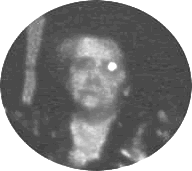
Fannie R. Wandless, from a 1950s TEHC banquet photograph. Photographer and date unknown. Tredyffrin Easttown Historical Society collections. Fannie R. Wandless, wife of Franklin W. Wandless and mother of Myrtle Wandless, alone seems to have done all the work in getting the Quarterly out in the 5 years between 1968 and 1973. The 6 issues published between 1968 and 1973 are very poor in physical appearance—the worst the Quarterly has ever looked in its first 70 years. One can find probable reasons for this:
Fannie died in 1975. While no one apparently helped her with the Quarterly between 1968 and 1973, no one stepped forward at all to keep the Quarterly going after she died. It languished completely for another 5 years—between 1973 and 1978. A look in the Minutes during the first 5-year period shows a lament for Fannie in April 1969 about the future of the Quarterly. During the second 5-year period the Minutes record no discussions or concerns from the TEHC membership about the lack of a Quarterly or even a suggestion to try and gear up and get it going once again. The Club still seems consumed, by the constant need for repairs at the Van Leer Cabin, a desire to sponsor their own 1976 Bicentennial event, and the temporary loss of their historical marker at the site of the Picket Post. The Minutes do not record any TEHC meetings at all in the 6 months between June 1970 and January 1971 and there are other months during these 5 years when there are no Minutes and therefore, apparently, no meetings. The Quarterly seems far from anyone's mind. 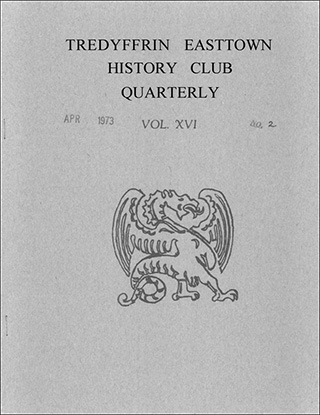
Front cover of the April 1973 Quarterly (volume 16, number 2), and the last issue published before the 5 year hiatus. The green cover has faded to a pale brownish-orange, there is a piece missing from the right side, the date is from a rubber stamp, the rub-on letters are in 2 styles, and the issue number is hand-written.This issue and the 5 issues published before this—between April 1968 and June 1972—all have the same cover illustration: the crude drawing of the Welsh dragon that is the TEHC emblem. 1978 – 2003 (volumes 16 – 40) Robert M[usselwhite] Goshorn, Editor 1978 – 1995 (Volume 16, no. 3 to Volume 33) 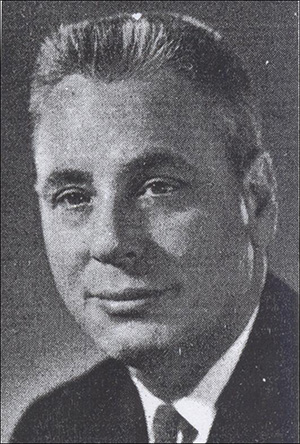
Robert M. Goshorn, Suburban and Wayne Times, October 12, 1967. Born on March 22, 1919, Bob Goshorn grew up in the 69th Street area of Philadelphia and lived in Malvern from 1928 to 1947. He was a graduate of Radnor High School, where he met his future wife, Elizabeth Taylor. Bob received a B.A. with high honors from Swarthmore College. He was an Infantry Captain in World War II, a prisoner of war in Europe, and was awarded a Purple Heart. He and Elizabeth lived at 1475 Russell Road and had 2 children: Kenneth, who died tragically; and Meg, an artist. Bob worked for Curtis Publishing Co. in New York City beginning in 1940 and was the circulation manager of 2 Curtis magazines, American Home and Country Gentleman. When he moved to this area in 1947, he continued to work at Curtis, commuting daily to New York City until 1977 when he retired at the age of 58. In 1964 he had moved up to vice president of the Curtis Circulation Co., a subsidiary of Curtis Publishing Co. Bob was scoutmaster of Boy Scout Troop 81 in 1952, president of the Chester County Historical Society between 1978 and 1982, a member of the local school board from August 1956 to December 1983 - more than 27 years - and a member of the Chester County Intermediate Unit Board of School Directors for 15 years. He was a member of the board of the Radnor Historical Society and President of the Friends group of the Tredyffrin Library. He was president of TEHC from 1978 to Helen Cooper's column, “Berwyn-Devon Datelines,” In the August 3, 1978 Suburban and Wayne Times announces the resumption of the Tredyffrin Easttown History Club Quarterly, “dormant” for 5 years. This column includes other recent TEHC news as did many other of Helen's columns for this newspaper. 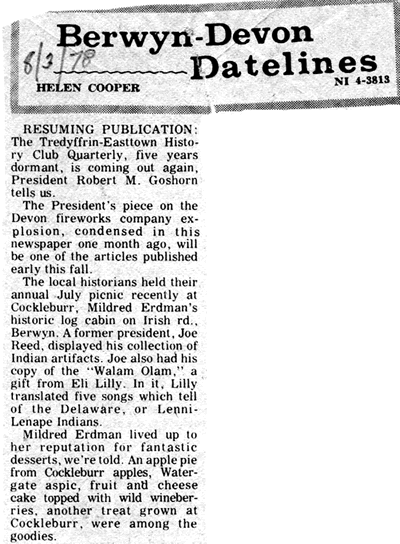
1981, and an acknowledged authority on local history. He died suddenly on November 21, 1995 following a stroke [Sources: (1) “Robert Goshorn Named Executive of Curtis Co,” Daily Local News, January 2, 1964; (2) “Magazine Group Elects Berwyn Man Secretary,” Daily Local News, November 19, 1966; (3) [no title], Suburban and Wayne Times, October 12, 1967; (4) “In Memoriam: Robert Musselwhite Goshorn,” Quarterly, vol. 34, no. 1 (January 1996), p. 41; (5) “Honoring Years of Service,” Suburban and Wayne Times, October 17, 1996]. Bob re-energized the Club and the Quarterly just when he was desperately needed. With his 37 years at Curtis, he was highly experienced in the business aspects of publishing, and, luckily for the Quarterly, was just the person it needed to turn it around. It didn't take him long. He got it back on a regular publication schedule of 4 issues a year, broadened the scope of its contents, and introduced the use of more modern production methods and technologies. He brought the Quarterly a much needed long period of stability. He quickly introduced 2 new regular features in the Quarterly. The first was “Notes and Comments,” a handy column where short news notes of important local history-based events or personal activities are published. Often this is the only place anything about persons, places, or events will be found. It first appeared in the Winter 1978 issue. The second, a column he now called “In Memoriam,” was continued from an earlier column called “Resolutions on Members' Deaths.” It started in the January 1979 issue. In his 2nd year as editor, Bob enlisted the collective knowledge of TEHC members who had lived in this area a long time and published a 3-part series on “Folk Names and Other Places No Longer on the Map,” a valuable source for local places whose names changed over time - material rarely found anywhere else. It was published in volume 17, nos. 2, 3, and 4 (April, July, October 1979). Bob describes the authority of the information in this series: The information concerning the various places is generally from secondary sources, and was taken in many instances from previous issues of the Quarterly. In other instances, it was derived from old maps, newspaper accounts, unpublished notes, and the recollections of or folk knowledge of various club members. An explanation of the source references is included at the end of the article [Quarterly, vol. 17, no. 2 (April 1979), p. 26]. Later, in the October 1982 Quarterly, Bob started the first of 20 “Club Members Remember” features, a very popular series he called “collective oral history.” The original one was “The First Family Car and Early Motoring” and the last one was “Traveling By Train” in the January 2001 issue. They were recorded, transcribed, and later included in the Quarterly. By the time Bob became editor, just about all the stories of the important historic events and locations in this area had been thoroughly researched and chronicled in the Quarterly. He turned to lighter, more popular local historical material and treatments. The January 1984 Quarterly (volume 22, no. 1) is typical of the kind of issues Bob edited. In addition to the usual “Notes and Comments” and 2 “In Memoriam” features, it has 6 short articles:
The cover illustration is a 1928 Wharton Esherick woodcut of “Winter Play Diamond Rock Hill.” Bob wrote 94 articles for the Quarterly under his name and another 16 under the name of Hob Borgson. He used this pseudonym when there was more than 1 article in an issue by him. In all cases he favored shorter type articles based on history and actual events but with more popular interest than in the earlier quarterlies. Bob apparently did not believe in naming himself as the editor, although it seems obvious he was doing a large amount of the work. No editorial staff is named for the first 3 years he edited the Quarterly. In January 1981 (volume 19, no. 1) an “editorial board” of 2 people—his wife, Elizabeth, and Leighton Haney—is first named and with the 2nd issue of 1982 (volume 20, no. 2) Bob adds himself as the 3rd member of the editorial board. These 3 names are the only ones listed in all the issues Bob edited. 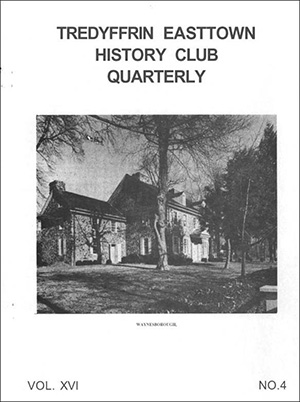
In just 2 issues—although 5 years had passed—the photograph of Waynesborough on the cover of the Winter 1978 Quarterly (volume 16, number 4), above, shows a noticeable improvement in the appearance of the front covers. New editor, Bob Goshorn, introduced production methods that allowed copies of photographs to be used directly on covers and inside pages. Photographs With the introduction of offset as the production method for the Quarterly, it could draw upon a much wider universe of illustrative matter and began using copies of originals of photographs, printed illustrations, more finely drawn matter, and other graphic images. This new ability to include good copies of photographs is immediately apparent with the 2nd issue Bob edited - Winter 1978 - where a large photograph of Waynesborough is reproduced on the green front cover and there are several more reproductions of photographs inside. Bob introduced the idea of pictorial portfolios. The first one is his own “A Portfolio of Old Picture Postcards from the Collection of the Tredyffrin-Easttown History Club” on pages 37-42 of the April 1979 issue—the 4th Quarterly under his editorship. It is quite successful and is a noticeable improvement over articles in earlier quarterlies. Artists With the increased use of photographs there was, perhaps, not quite as much of a need to rely on artists to draw the illustrative matter for the Quarterly. Bob drew his own illustrations for almost all of his articles, but doesn't give himself credit for any of them. In addition, he knew he could go to any of the stock photo houses for copyright-free reproducible images to use in an issue of the Quarterly. He does use the work of 2 other artists. Linda McNeil is a serious Chester County painter who specializes in detailed watercolors of historic Chester County buildings [“1987 Was a Very Good Year for this Local Artist,” Suburban and Wayne Times, January 7, 1988]. Her “Diamond Rock School: A Pictorial Portfolio” appears on pages 51-60 of the April 1983 Quarterly and her “The Knox Covered Bridge: A Pictorial Portfolio” appears on pages 107-114 plus the front cover of the July 1990 Quarterly. Linda is the author of the Diamond Rock School article that has views by 8 different artists—the view on page 53 is by Linda. The many views in the Knox Covered Bridge article appear to have been compiled by Bob Goshorn. Linda drew 3 of the illustrations: the one on the front cover and the 2 on page 110.
Linda McNeil. Suburban and Wayne Times, January 7, 1988. Linda was a member of TEHC and used her library science training to compile the cumulative index to volumes 14 to 18 (1966-1980) of the Quarterly. Meg Fruchter is Bob Goshorn's daughter and she illustrated at least 4 articles for the Quarterly:
C[larence] Herbert Fry, Editor 1996 – 2003 (Volume 34 to volume 40, no. 2) 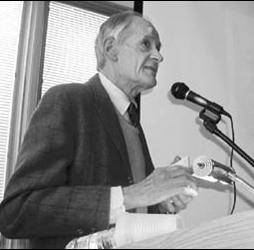
C. Herbert Fry. January 11, 2004 kickoff for the Easttown Township tricentennial celebration. Photographer Ryan Richards, Suburban and Wayne Times. Courtesy DH2 Design Communications. Herb was born on June 27, 1926 in Pottstown, Pennsylvania and grew up on a farm near there. After high school he served with the 69th Infantry Division AUS, 1944–46. In 1950 he received a B.S. degree from Syracuse University and married Barbara Ruth McGuire on August 28, 1950. They have 4 children. He has lived in Berwyn since 1953. After graduation Herb began a 20-year career as a CPA with the Philadelphia office of what was then Peat, Marwick, Mitchell & Co. In 1969 he moved to the American Stores Company, now the third largest grocery store chain in the United States - and includes Acme - as chief accounting officer. He was senior vice-president, treasurer, and controller for the company by the time he retired in 1990. Herb is this area's leading historian. He was the president of the Tredyffrin Easttown History Club from 1992 to 1995, vice-president from 1996 to 2002, and editor of the Quarterly from 1996 to 2003. He has been a member of the board of directors of the Tredyffrin Historic Preservation Trust since 2003; a consultant to the Easttown Township Historical Commission; and author of Easttown: Old in History, Young in Spirit, 1794–2004, a 151-page book published in 2004, and written on the occasion of the Easttown Township tricentennial [Sources: (1) Who's Who in America 2007. 61st ed. New Providence, NJ: Marquis Who's Who, 2006, p. 1,529; (2) “Reader of the Week: Herb Fry,” Suburban and Wayne Times, July 26, 2007]. Herb joined the staff of the Quarterly in October 1992 and is listed as the 4th member of the editorial board beginning with that issue. In 1996, with the first issue published after Bob Goshorn's death in 1995, Herb became the editor although he followed Bob's policy of listing himself only as a member of the editorial board. The quarterlies under Herb's editorship are the first ones produced using computer composition techniques. His layout is clean, crisp, and uncluttered in style with lots of white space. His earliest issues have few illustrations, but as Herb grew more comfortable with the software, more illustrations were added. Herb expanded the western boundaries of the area the Quarterly traditionally covered and started including articles about East Whiteland Township. Since he is a long-time resident of Berwyn, his interests and research almost always focuses on the Easttown area. He also revived interest and promoted research into the businesses and industries of this area, started back in the mid-1960s with the articles by Sara B. Nuzum. Herb has written 36 articles for the Quarterly since 1989 and is a continuing contributor. His first article is “The Amusement Park on the Trolley Line” in the July 1989 issue, a hint that he would write future articles about entertainment, musical events, dance bands, local musicians, etc., topics that had not been covered in the Quarterly before Herb wrote them. Herb follows Bob Goshorn's policy of using a pseudonym when he has more than 1 article in the same issue and wrote 3 articles as Frank Fuller, one each in 1996, 1997, and 1998. Artists Sue Andrews is the major historian of old houses and early communities in the northwest corner of the Great Valley. Her thorough house research is supplemented with her extensive pen and ink drawings of many of the local houses, buildings, and structures in the communities she writes about. She also draws detailed hand-drawn maps of the early street plans of these communities. Sue has published 5 major articles in the Quarterly, each of which contains original material never before published and large numbers of her pen and ink drawings:
Sue Andrews' pen and ink drawing of her and her husband, Bill's, farm off Yellow Springs Road in Cedar Hollow. This, and many other of Sue's drawings, have been a series of Andrews' Christmas cards for several years. This farm has been the scene of the annual TEHC/TEHS summer picnics since 1996. Sue supplied many additional pen and ink drawings to illustrate other articles in the issues of the Quarterly that Herb edited. He didn't have the resources to continue illustrating issues the way Bob Goshorn had done and had gone back to an earlier “cut and paste” method in order to be able to include many illustrations in his issues. Sue's drawings based on original photographs or newspaper article illustrations are just the thing to complement the crisp look of Herb's issues. Sue and her husband, Bill, live in a very old 1732 farm off Yellow Springs Road. A Quarterly article about their own house and farm, “An Old Road and a Dig: Discovering the History of a House in the Valley,” was published in the Summer 2006 issue. With its inclusion of both scanned digital images of some of Sue's material plus photocopies of her original pen and ink drawings, it is a transition article, illustrating the use of both new and old methods to insert images into the Quarterly. From this point on, digital photographs are used almost exclusively and there is no longer a need to use some form of a copy of an image to include it in an issue. 2003 to date (volumes 40 to date) Joyce A[rnold] Post, Editor 2003 to date (Volume 40, no. 3 to date) 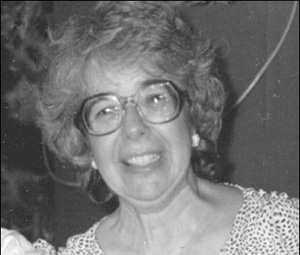
Joyce. A. Post. June 14, 1994. Photographer unknown. Courtesy Joyce A. Post. Joyce was born on January 10, 1939 in Harrisburg, Pennsylvania. She received a B.A. degree from Susquehanna University in 1960 and an M.S. degree in library science in 1961 from what was then Drexel Institute of Technology. She married J. B. Post, another librarian, in 1967 and they lived in the University City area of Philadelphia for 29 years. They have one son and 2 granddaughters. Between 1961 and 1999 Joyce alternated between library and indexing positions. She prepared the annual indexes to Special Libraries, supervised the production of the 25-year index -1953-1977 - to TV Guide for Triangle Publications in Radnor, and was the senior index editor and index supervisor for the 21-volume Academic American Encyclopedia. She was also a member of the board of directors of the American Society of Indexers and editor of their newsletter. She was a founding member of the Gerontology Special Interest Group of the Medical Libraries Association. After retiring and moving to Paoli in 1999, she began assisting with the production of the Quarterly in July 2002 and introduced the use of word processing software in the layout and design of the pages at that time. Joyce's husband, J. B. Post, provided invaluable all-round support from listening to the editor's cries of frustration when the various computer programs used to produce the Quarterly exhibited minds of their own, to serving as the official expert on local maps as well as matters of copyright, to managing subscription lists and charges, to endless miles of driving around to locate material and facts and deliver and mail issues fresh from the printer, and to reply to the steady stream of requests for copies of back issues. Joyce has written 8 articles for the Quarterly. 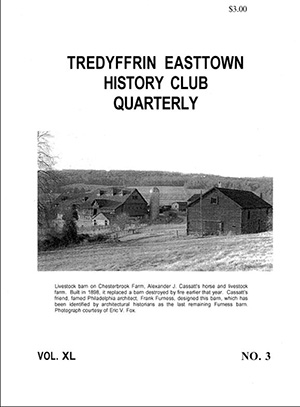
The first phase of the major overhaul of the Quarterly was with this July 2003 issue. It is the first issue to use a white cover and to be produced using desktop publishing methods. 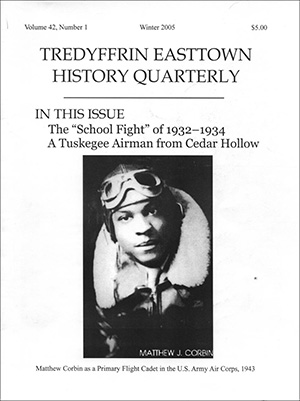
The most recent changes of the appearance of the Quarterly began with this Winter 2005 issue. The title was changed to Tredyffrin Easttown History Quarterly, a brief preview of the issue contents was included on the cover, and volume numbers were changed to Arabic. With the July 2003 issue (volume 40, no. 3) Joyce began a major overhaul of the appearance of the Quarterly to make it more interesting to the general reader and give it a more modern look:
With these changes the following decisions were also made:
Digitized Resources Many modern readers are attracted to printed matter if it contains large numbers of photographs, especially old ones, and text is presented in relatively short segments. Because the Quarterly is rooted in a scholarly tradition with long paragraphs of written historic details and little illustrative matter, and because these traditions are what has made it so valuable in the past and must therefore be retained, it is a challenge to merge these old principles with the new production methods. Text grounded in historical research is still the basis of any article in the Quarterly no matter how long or short. But now large amounts of illustrative matter are added, greater use is made of headings and subheadings to break up text, and electronic methods of page layout are used to merge text and images in a more exciting-looking page though still keeping the look of a serious publication. The July 2003 Quarterly introduced a new regular feature—“Then ... & Now”—always on the last page of each issue, to make greater use of the TEHS photograph collection and to present history in a short graphic format. It presents 2 photographs: an old one and a contemporary one taken at the same location as the original, plus an extensive caption describing the historical background of the 2 images. The Berwyn Ice Plant is the subject of the first “Then ... & Now” and since then, 15 additional installments of this feature have been published. All illustrative matter now has captions and, when known, the names of photographers and the dates photographs were taken are documented. Digitized photographs are much more accessible to users and most lenders will allow their use as long as permission and courtesy statements are given. This type of information was not usually provided for illustrative matter in earlier issues of the Quarterly. It wasn't as necessary then as it is now. The first major use in the Quarterly of digitized material is the 15 photographs and maps in a series of 4 articles on Valley Forge industry in the Summer 2004 issue. In addition to images from the authors, extensive use is made of digitized photographs from Valley Forge National Historical Park and the Historic American Buildings Survey of the Library of Congress. With digital methods, images from a wide range of sources are now available to illustrate articles. The Quarterly downloaded an electronic planning map from Tredyffrin Township to illustrate an article in the Fall 2004 issue about the transformation of the old Wilson family Elda Farm into the new Wilson Farm Park. An electronic version of an aerial photograph of the Howellville quarries was obtained from Chester County Geographical Information Systems to illustrate an article in the Summer 2005 issue. Issues are now usually filled with at least 40 photographs and other images. Extensive use is now made of digital images of segments of maps from the large property and railroad atlases in the TEHS collection to illustrate articles. The original hand-drawn maps were absolutely necessary to illustrate articles in earlier issues, and for showing property lines before any atlases of our area were available. Now these atlases have become a valuable resource and we routinely take our tripod and digital camera to the atlases - they're too unwieldly to carry very far - and shoot an authoritative image of just the piece of property needed to illustrate an article. New Directions In addition to bringing an awareness of photographic resources to the Quarterly, Joyce has focused on the historical background of current events and places. When, for example, Conestoga High School's Teamer Field underwent a major renovation in the fall of 2005 it was an excuse to delve into the background of this 55-year-old playing field and publish that story in the Fall 2005 Quarterly in a timely fashion to coincide with the rededication of the field. Joyce has also tried to promote the idea of the Quarterly as the publishing venue for anyone in the Main Line area who has produced scholarly written history-based material of article length and is looking for a place to publish it. When the grandson of the builder of Strafford Village wanted to publish his story of how the village was built, the Quarterly was happy to oblige with an article in the Winter 2004 issue. 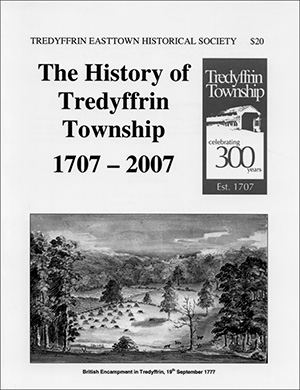
Tredyffrin Township celebrated its 300th anniversary in 2007 and the Tredyffrin Easttown Historical Society published a 300-year history of the Township as its contribution to the celebration. The title is “The History of Tredyffrin Township: 1707–2007.” It is a collection of 37 articles from earlier issues of the Tredyffrin Easttown History Club Quarterly and the Tredyffrin Easttown History Quarterly with many new photographs and images added. This 89-page volume is the first Quarterly to have a front cover in color. It is guest edited by Mike Bertram and is published as volume 44. nos. 1 & 2 (Winter/Spring 2007) of the Tredyffrin Easttown History Quarterly. This is the first history of Tredyffrin Township ever published, is a runaway best seller, and has gone to a second printing. INDEXES Access to the contents of all the quarterlies has always been available. The last issue of every volume has an annual index. Over the past 70 years this has been accomplished by different individuals with different ideas on how to go about doing it. This has led to uneven levels of access and different methods of arranging the entries. The indexers—whether they were aware of it, or not—produced two different types of “indexes” to the Quarterly. ANNUAL INDEXES The annual indexes to individual volumes appear, with a few exceptions, in the back of the last issue in that volume. Of all the indexes to the Quarterly these most resemble standard indexes with names of places and people put in alphabetical order within the index. You'll find the reference to the article about Thomas G. Aiken, M.D. in volume 10 in its index in the “A”s. When Bob Goshorn became the editor in 1978 the 2 new features he had introduced, “Notes and Comments” and “In Memoriam,” required a different indexing approach. Attention was needed to first make sure there were references to each proper name in these 2 features, and second, that they appeared in their expected alphabetic order in the subject index. Bob understood the importance of this and the indexes to volumes 17– 29 (1979–1991) by him and to the later volumes 39–44 (2002–2007) by Joyce Post, assistant and editor during these years, are the most useful of the annual indexes. The indexers to the 10 years of annual volumes between 1992 and 2001 usually list personal names and place names only under the broad topic of “In Memoriam” or the broad topic that the “Notes and Comments” item is about. The reference to the news note about Julie Nixon Eisenhower, for example, in volume 30 is found in the subject index only under the subhead “Notes and Comments” at the end of the index after “W.” All “Notes and Comments” references are grouped here. You won't find Julie in the main part of the index under “E.” CUMULATED INDEXES The need for a cumulated index first comes up as far back as 1958. “Dr. Mason recommended an index of all numbers published from the beginning after the completion of Vol. X” [M1/23/58]. Nothing happened. It isn't until 8 years later in 1965 that it comes up again. “Mrs. Wandless asked if we want an index number which will cost about twenty dollars. A motion was made and carried to have the index number” [M7/22/65]. In 1965 the Quarterly states “The TREDYFFRIN-EASTTOWN HISTORY CLUB wishes to announce the publication of a complete index, to date, of the Tredyffrin-Easttown History Club Quarterly from Volume I, No. 1 to Volume XIII, No. 4” [Quarterly, vol. 13, no. 4 (October 1965), p. 94]. Two years later, in 1967, “It was reported there are about 20 copies of the Index still on hand” [M2/26/67]. The 3 cumulated indexes published in 1965, 1981, and 1995 use a different approach than the annual indexes. The references to all articles are placed under one of between 32 and 68 large general topics. Here you have to know that references to articles about individual persons are found under the heading “Biography, Autobiography.” You'll rarely find them under their own name in the alphabetic arrangement. If you don't know that the Good Samaritan Church is Episcopalian and you don't know that all references to churches are under the “Religion” topic in the cumulated indexes, you are not going to find the article about the church in volume 9. If you want to know what has been written about Chesterbrook, for example, the references to the 10 articles about it written before 1995 are scattered around under 3 different broad topics: “Agriculture, Horticulture,” “Landmarks, Homes,” and “Reminiscences;” topics you might not to think to look under. There is nothing under “C.” Each of the 3 cumulative indexes to the Quarterly is issued as a separate publication. First Cumulated Index – 1937-1965 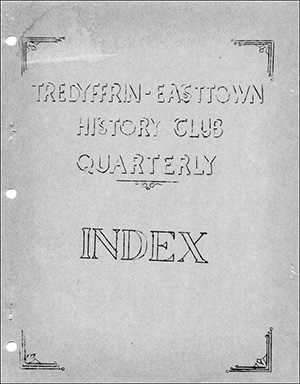
The first cumulated index to the Quarterly covers the first 13 volumes (1937 to 1965). It has 24 pages and was separately published. The first one covers the first 13 volumes (1937–1965) and has no publication date but it was announced in 1965 to celebrate the 30th anniversary of the Club. According to TEHC Minutes it “was made by Mrs. and Miss Wandless” [M3/9/66]. It is 24 pages and is arranged by 34 broad topics. This works in this case, because it is a small index to just 33 issues. Three of these 34 topics are “Club Trips,” which indexes 13 TEHC trip narratives; “Editorials,” with references to the 29 editorials in the first 13 volumes and a good source for early Club actions; and “Poems,” a list of 17 poems, usually by Club members. These include the well-known “Sorrel Horse Toast” (volume 5, no. 2, p. 37) and the 29-line clichéd acrostic poem by J. Alden Mason to the first letters of “Tredyffrin Easttown History Club” reading down (volume 1, no. 4, inside back cover). Two extensive—and quite valuable—detailed separate indexes also appear. One is to the 340 illustrations and the other is to the 68 individual maps in these volumes. The final separate index is an author index which shows that Franklin L. Burns was the most prolific author during this period, with 26 articles and 9 editorials. Second Cumulated Index – 1966-1980 The second cumulative index, published in 1981, begins where the first cumulated index ends and covers volumes 14 (1966) to 18 (1980). It is 12 pages and is compiled by Linda McNeil, Media Specialist at Valley Forge Junior High School. It was typed by Sue Barnes of Tredyffrin Township. Its entries are grouped under 32 separate broad topics. It includes 6 editorials and 1 poem and reflects the fact that these now appear less frequently in the Quarterly. Third Cumulated Index – 1937-1994 The third cumulative index was produced at a time when simple computing power was available to manage the production of large indexes like this third one for the Quarterly. As late as the 1990s the Club was just beginning to understand how computers could work for it. All it had to produce this “index” was limited access to very elementary software made available by another organization and little understanding of how to use it. This index goes back to the first volume and covers the first 32 volumes of the Quarterly - from 1937 to 1994. It was published in 1995 and is 49 pages long. It follows the standard arrangement of separate subject and author indexes used by all the annual indexes and the 2 previous cumulative indexes. It lists references to over 550 articles under broad topics - now there are 54 - 68 if you also count the 14 denomination subdivisions under “Religion.” It is now a very large index that has no direct references to any specific names or subjects. In this index, if you want to find that article about Thomas Aiken in volume 10 you have to know to look under the topic “Biography, Autobiography.” There is no direct entry in the overall index under “A” as there is in the annual index for that volume. A listing under the topic “Biographies” is also how it is arranged in the first cumulative index 29 years earlier, but this is a much smaller index of just 24 pages and it is not as difficult to find the reference. With material in the subject index not directly entered under names and with it now scattered around under very broad topics it is rather difficult to find anything in this compilation. The same problems described above are also prevalent. These are compounded for the user by his having to know that the “In Memoriam” topic is in the subject index and the “Notes and Comments” topic is in the author index. An index of this size always needs an editor. The final topic, for example, in the author index, “Zz Author Not Named” - an unedited computer sorting convention - was used to force a very long catch-all list of undifferentiated miscellaneous references to the end of the author listing. In addition, here, among all the entries, the 15 articles beginning with “The” are alphabetized under “T.” Article continues on page 169 with "70 YEARS OF PRODUCTION METHODS " |
